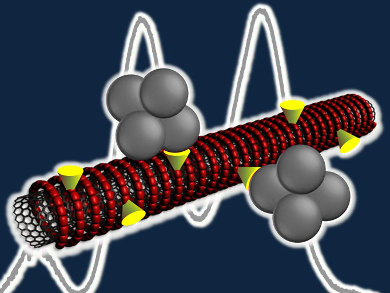The selective detection of compounds of biological interest with high sensitivity is crucial for the early detection and diagnosis of many health issues. Eric Doris, IBITECS, Gif-sur-Yvette, France, Laurent Vivien, Université Paris-Sud, Orsay, France, and colleagues have synthesized a polyfluorene polymer bearing azido groups that was used for the selective extraction of semiconducting nanotubes from the bulk population.
The resulting composites were further modified at the azido groups on the polymer by conjugation of a model ligand (biotin) using click chemistry. In order to investigate the sensing properties of the biotin/nanotube platform, specific interactions with a streptavidin target were explored. The interactions lead to marked shifts of the photoluminescence of the nanotubes.
The results demonstrate the concept of a new type of biosensor relying on the optical properties of carbon nanotubes. The azide-functionalized platform can accommodate an extremely wide range of ligands or receptors and thus be adapted to the specific detection of a variety of disease markers or other analytes of interest.
- Polymer-Decorated Carbon Nanotubes as Transducers for Label-Free Photonic Biosensors,
Elise Villemin, Edmond Gravel, Nicolas Izard, Arianna Filoramo, Laurent Vivien, Eric Doris,
Chem. Eur. J. 2015.
DOI: 10.1002/chem.201503741



